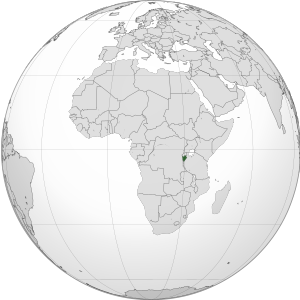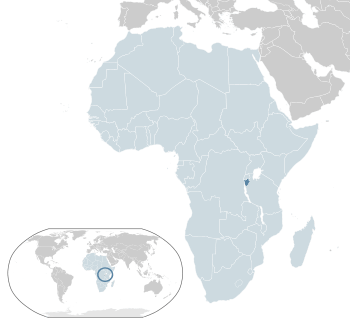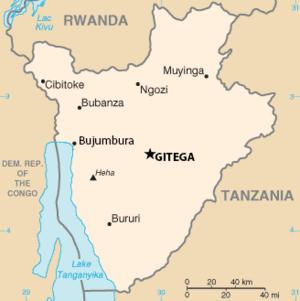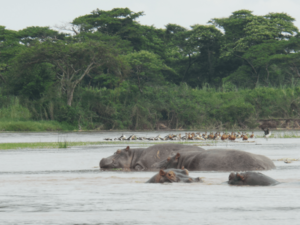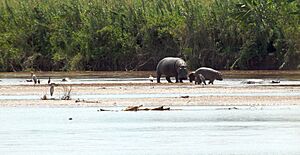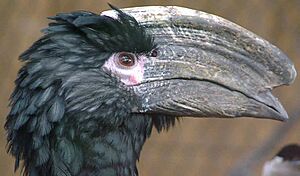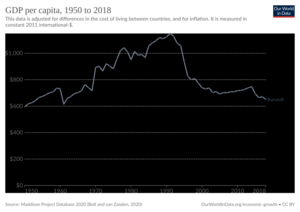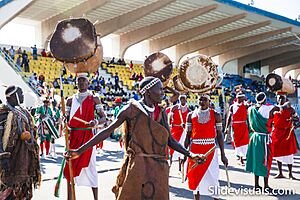Burundi facts for kids
Quick facts for kids
Republic of Burundi
|
|
|---|---|
|
|
|
|
Motto:
|
|
|
Anthem: "Burundi Bwacu" (Kirundi)
"Our Burundi" |
|
| Capital | Gitega 3°30′S 30°00′E / 3.500°S 30.000°E |
| Largest city | Bujumbura |
| Official languages | |
| Ethnic groups | |
| Religion
(2020)
|
|
| Demonym(s) | Burundian |
| Government | Unitary dominant-party presidential republic under an authoritarian dictatorship |
| Évariste Ndayishimiye | |
| Prosper Bazombanza | |
| Gervais Ndirakobuca | |
| Legislature | Parliament |
| Senate | |
| National Assembly | |
| Establishment history | |
|
• Kingdom of Urundi
|
1680–1966 |
|
• Part of German East Africa
|
1890–1916 |
|
• Part of Ruanda-Urundi
|
1916–1962 |
|
• Independence from Belgium
|
1 July 1962 |
|
• Republic
|
28 November 1966 |
|
• Current constitution
|
17 May 2018 |
| Area | |
|
• Total
|
27,834 km2 (10,747 sq mi) (142nd) |
|
• Water (%)
|
10 |
| Population | |
|
• 2024 estimate
|
14,151,540 (78th) |
|
• Density
|
473/km2 (1,225.1/sq mi) (17th) |
| GDP (PPP) | 2023 estimate |
|
• Total
|
|
|
• Per capita
|
|
| GDP (nominal) | 2023 estimate |
|
• Total
|
|
|
• Per capita
|
|
| Gini (2020) | ▼ 37.5 medium |
| HDI (2022) | low · 187th |
| Currency | Burundian franc (FBu) (BIF) |
| Time zone | UTC+2 (CAT) |
| Driving side | right |
| ISO 3166 code | BI |
| Internet TLD | .bi |
Burundi, officially called the Republic of Burundi, is a small country in Africa. It is located in the eastern part of Central Africa. The capital city of Burundi is Gitega. However, Bujumbura is the largest city and the economic center.
Burundi has four official languages: Kirundi, French, English, and Swahili. About 14 million people live in Burundi. The country is known for its beautiful landscapes and rich culture.
Contents
Provinces and Cities in Burundi
Burundi is divided into smaller areas to help with government. These areas are called provinces, which are then split into communes. The communes are further divided into even smaller areas called collines, which means "hills."
There are 17 provinces in Burundi. Each province has its own local government. For example, the area around Bujumbura used to be one province. But in 2000, it was split into two: Bujumbura Rural and Bujumbura Mairie (which includes the city itself).
Here are the provinces of Burundi:
What are the Largest Cities in Burundi?
These are the biggest cities in Burundi by population:
| Ranking | Name | Population |
|---|---|---|
| 1. | Bujumbura | 340,300 |
| 2. | Gitega | 46,900 |
| 3. | Muyinga | 45,300 |
| 4. | Ngozi | 40,200 |
| 5. | Ruyigi | 36,800 |
| 6. | Kayanza | 26,200 |
| 7. | Bururi | 22,900 |
| 8. | Rutana | 20,700 |
| 9. | Muramvya | 17,600 |
| 10. | Makamba | 13,000 |
Geography and Nature of Burundi
Burundi is one of Africa's smallest countries. It is a landlocked nation, meaning it has no coastline. The country has a tropical climate, which means it's warm and humid.
Burundi is part of the Albertine Rift. This is a western extension of the larger East African Rift, a huge crack in the Earth's surface. The country sits on a rolling plateau, which is a high, flat area of land.
Burundi shares borders with Rwanda to the north, Tanzania to the east, and the Democratic Republic of the Congo to the west. Its natural areas include forests and savannas.
Mountains and Rivers
The central plateau of Burundi is about 1,700 meters (5,600 feet) high. The highest point in the country is Mount Heha, which is about 2,685 meters (8,810 feet) tall. It is located southeast of Bujumbura.
The source of the Nile River, one of the world's longest rivers, is found in Burundi's Bururi province. Water flows from Lake Victoria into the Nile through the Ruvyironza River. Lake Tanganyika, a very large and deep lake, forms much of Burundi's southwestern border.
Forests and Parks
About 11% of Burundi's land is covered by forests. In 2020, this was about 279,640 hectares of forest. Many of these forests are natural, while some are planted. A good portion of the forest area is protected.
Burundi has two important national parks:
- Kibira National Park: This park is in the northwest. It has a small rainforest area.
- Ruvubu National Park: This park is in the northeast, along the Rurubu River.
Both parks were created in 1982 to protect the country's amazing wildlife.
Wildlife in Burundi
Burundi is home to many different kinds of plants and animals. It has about 2,950 types of plants, 596 kinds of birds, and 163 types of mammals. There are also many reptiles, amphibians, and fish.
Sadly, the number of wild animals has gone down a lot. This is mainly because more people live there, and forests are being turned into farms. Only about 5% of the country's land is protected for wildlife.
Plants of Burundi
The plants in Burundi include evergreen bushes and grasslands. In the western mountains, you can find rainforest plants. Near the lakes, there are Hyphaene and Acacia trees. Some areas have many Acacia and Combretum trees.
There are 2,950 known types of vascular plants in Burundi. Many plants found in high-altitude areas are unique to Burundi. About 70 plant species are found only here.
Animals of Burundi
Burundi has 163 types of mammals, 52 reptiles, 56 amphibians, and 215 fish species. Many animals found at high altitudes are also unique to Burundi. Lake Tanganyika alone has 200 types of fish and many kinds of mollusks.
In 2011, scientists found the Bururi long-fingered frog in the Bururi Forest Nature Reserve. This frog was thought to be extinct since 1949!
Some important animals found in Burundi include:
- Genetta piscivora (aquatic genet)
- Serinus mozambicus (yellow-fronted canary)
- Cercopithecus lhoesti (L'hoest's monkey)
- Agapornis fischeri (Fischer's lovebird)
- Galago moholi (South African galago)
- Hippopotamus amphibius (hippopotamus)
Some animals in Burundi are endangered or vulnerable. This means their numbers are very low, and they are at risk of disappearing. These include:
- Chimpanzee (endangered)
- African wild dog (endangered)
- African golden cat (vulnerable)
- Cheetah (vulnerable)
- Lion (vulnerable)
- Spotted-necked otter (vulnerable)
Mammals in Burundi
Burundi has different types of African buffalo. The West African savanna buffalo, for example, has only about 500 left. Sitatunga (a type of antelope) used to live in many swamps but are now rare.
Other animals like Waterbuck and Lichtenstein's hartebeest were once common. Some animals, like the Korrigum (a type of antelope) and Impala, are no longer found in Burundi. The Grey duiker is still found in good numbers, especially in Ruvubu National Park.
Birds in Burundi
Burundi has 596 types of birds. Many of these birds live there all year, while others migrate for certain seasons. There are no bird species found only in Burundi.
BirdLife International has named five "Important Bird Areas" in Burundi. These areas protect birds and cover about 3.7% of the country. They include national parks and forest reserves.
Some bird species in Burundi are of global concern, meaning they need protection. These include the Lesser Flamingo, Pallid Harrier, Lesser Kestrel, Great Snipe, Black-winged Pratincole, Madagascar Pond Heron, Red-faced Barbet, Ruwenzori Apalis, Papyrus Gonolek, Shoebill, Grauer's Warbler, Shelley's Crimsonwing, Papyrus Canary, and Wattled Crane.
Economy of Burundi
Burundi is a country with limited resources and not much industry. Its economy mostly relies on agriculture. Farming makes up about 50% of the country's total income and employs over 90% of the people. Most farming is subsistence farming, where people grow food mainly for themselves and their families.
Burundi's main exports are coffee and tea. These two products bring in 90% of the money the country earns from other countries. Other farm products include cotton, maize (corn), sweet potatoes, bananas, and cassava.
Many people in Burundi struggle to grow enough food because of a growing population and unclear rules about land ownership. In 2014, the average farm size was very small, about one acre.
Burundi faces many economic challenges. About 80% of its people live in poverty. There have been times of food shortages. The country's income from exports depends a lot on the weather and the prices of coffee and tea around the world.
Burundi relies heavily on help from other countries and organizations. Foreign aid makes up 42% of its national income. This is one of the highest rates in Africa. In 2009, Burundi joined the East African Community, which helps with trade in the region.
Burundi has some natural resources like uranium, nickel, cobalt, copper, and platinum. Besides farming, other industries include putting together imported parts, building public works, processing food, and making simple goods like blankets and soap.
The country's internet and communication technology is still developing. Access to banking services is also limited for most people, especially in rural areas. However, Microfinance (small loans and financial services) is becoming more common.
Burundi's economy has faced difficulties since the 1990s. It is working to improve its situation and develop. In 2024, Burundi was ranked 127th in the Global Innovation Index.
What is Burundi's Currency?
Burundi's money is called the Burundian franc (FBu). It used to be divided into 100 centimes, but centime coins are no longer used. The central bank, called the Bank of the Republic of Burundi, manages the country's money.
How Do People Travel in Burundi?
Burundi's transportation system is limited. It is not very developed. In 2012, Burundi was ranked as one of the least connected countries in the world.
Bujumbura International Airport is the only airport with a paved runway. Several airlines fly there, connecting Burundi to cities like Brussels, Addis Ababa, Nairobi, and Kigali.
The country has a network of roads, but in 2005, less than 10% of them were paved. Private bus companies operate buses on the route to Kigali in Rwanda. There are no direct bus connections to Tanzania or the Democratic Republic of Congo.
A ferry called the MV Mwongozo connects Bujumbura to Kigoma in Tanzania across Lake Tanganyika. There are also plans to build a railway line to connect Burundi to Rwanda, Uganda, and Kenya in the future.
People and Culture of Burundi
As of 2021, Burundi had a population of over 12 million people. This is a big increase from 1950, when there were only about 2.4 million. The population is growing quickly. On average, a Burundian woman has 5.10 children, which is more than double the global average.
Most Burundians live in rural areas, with only about 13% living in cities in 2013. The country has a high population density, meaning many people live in a small area.
The main ethnic groups in Burundi are the Hutu (about 85%), the Tutsi (about 14%), and the Twa (less than 1%).
What Languages are Spoken in Burundi?
The official languages of Burundi are Kirundi, French, and English. English became an official language in 2014. Almost everyone in Burundi speaks Kirundi. French is spoken by just under 10% of the population.
What Religions are Practiced in Burundi?
Most people in Burundi are Christian, making up about 80–90% of the population. The largest Christian group is Roman Catholics. Protestants and Anglicans make up the rest.
About 5% of the population follows traditional local religious beliefs. Muslims make up 2–5% of the population, mostly living in cities.
Culture and Traditions of Burundi
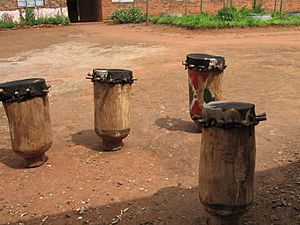
Burundi's culture is a mix of local traditions and influences from nearby countries. Farming is very important, so a typical Burundian meal often includes sweet potatoes, corn, rice, and peas. Meat is usually eaten only a few times a month because it can be expensive.
When friends and family gather, they sometimes share impeke, a type of beer, from a large container. This symbolizes their unity.
Crafts are a big part of Burundian art. Tourists often buy items like woven baskets, masks, shields, statues, and pottery.
Drumming is a very important part of Burundi's cultural heritage. The famous Royal Drummers of Burundi have performed for over 40 years. They use traditional drums like the karyenda. Dance often goes with drumming, especially during celebrations. Some popular dances are the abatimbo and the fast-paced abanyagasimbo. Musical instruments include the flute, zither, and umuduri.
Storytelling, poetry, and songs are important ways to share history and life lessons. These are part of Burundi's strong oral tradition.
Sports like basketball and track and field are popular. Association football (soccer) is also very popular across the country. Many people enjoy playing traditional board games like mancala.
Most Christian holidays are celebrated, with Christmas being the biggest. Burundian Independence Day is celebrated every year on July 1st. In 2005, the government also made Eid al-Fitr, an Islamic holiday, a public holiday.
Education in Burundi
In 2012, about 74.71% of adults (15-24 years old) in Burundi could read and write. For young people, this rate was even higher, at 92.58%. Burundi has a fairly good literacy rate compared to other countries in its region.
Burundi has one public university, the University of Burundi. There are also museums, such as the Burundi National Museum in Gitega. In 2010, a new elementary school was opened in Rwoga, funded by students from Canada. In 2022, Burundi spent 5% of its total income on education.
Science and Technology in Burundi
Burundi has a plan for science, technology, research, and innovation. This plan covers areas like food, medicine, energy, mining, water, and information technology.
Medical research is a main focus. In 2018, medical researchers made up 4% of the country's scientists. They wrote 41% of scientific papers between 2011 and 2019.
The plan also focuses on training more researchers. The number of researchers per million people grew from 40 to 55 between 2011 and 2018. The money available for each researcher also increased.
Burundi has almost tripled its scientific output since 2011. However, it still has one of the lowest rates of scientific publications in Central and East Africa. Most of Burundi's scientific papers are written with foreign co-authors.
Related Pages
See also
 In Spanish: Burundi para niños
In Spanish: Burundi para niños




